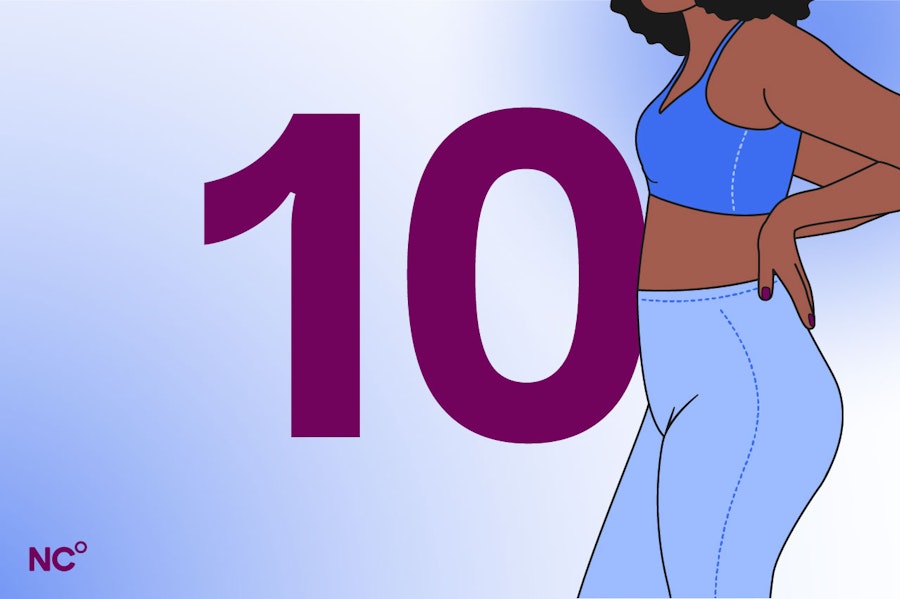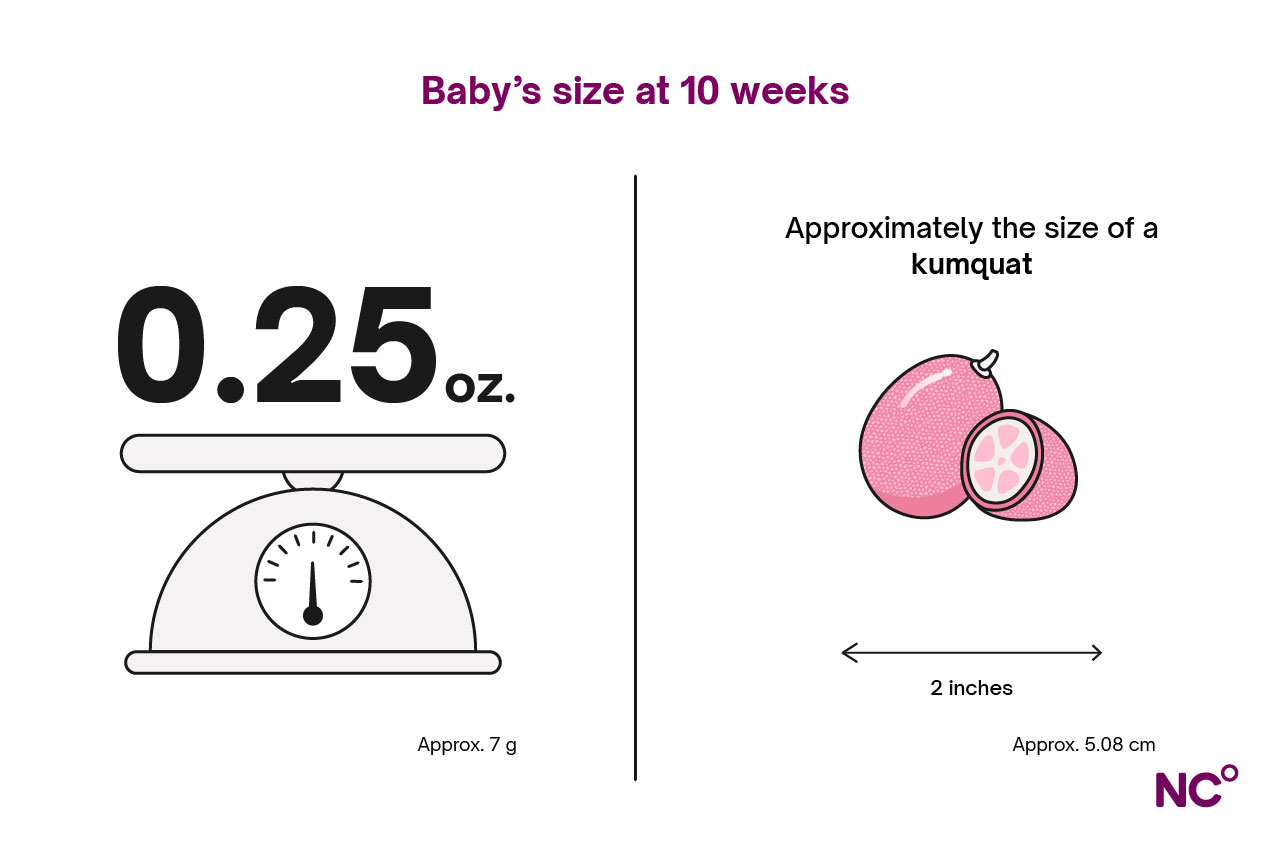10 Weeks pregnant: Pregnancy symptoms & tips
Follows NC° Editorial Policy
At Natural Cycles, our mission is to empower you with the knowledge you need to take charge of your health. At Cycle Matters, we create fact-checked, expert-written content that tackles these topics in a compassionate and accessible way. Read more...
Key takeaways
- Week 10 can bring about some digestive discomfort, emotional mood swings, and changes to your hair, skin, and breasts
- The fetus is currently developing distinct facial features, and its limbs are growing rapidly. Its heartbeat is about three times as fast as yours to support this growth
- In addition to your 10-week scan that will provide your estimated due date, you may want to explore additional screening tests like non-invasive prenatal testing (NIPT) at this time
- Your body is going through many changes, so taking care of your mental, emotional, and physical health is key this week
You’ve made it to 10 weeks pregnant! You’re nearing the end of your first trimester, and you may have booked your first appointment with a midwife or doctor this week. In this article, we’ll go over some common symptoms you can expect at 10 weeks pregnant, along with details about the baby’s development and what you can expect at your 10-week ultrasound.
Pregnancy symptoms at week 10
Before we dive into symptoms you can expect at 10 weeks pregnant, we wanted to provide a gentle reminder that every pregnancy is unique. The symptoms detailed below may occur sooner or later than week 10, and it’s equally possible that you may not experience them at all [1]. This guide is meant to give generalized information, and it should not be substituted for advice and care from your medical team.
With that in mind, let’s go through some of the most commonly reported symptoms at 10 weeks pregnant:
Bloating and digestion
At this point in the pregnancy, your main symptom may be digestive issues. Feeling particularly bloated, gassy, and/or constipated is common. You may also experience heartburn, nausea, a metallic taste in your mouth, and new cravings or aversions to certain foods. Your uterus is about the size of a large orange, so while you may not have a baby bump just yet, you could notice your clothes getting tighter [2].
This is all thanks to the hormone progesterone — one of its functions is to relax the muscles of the womb to allow it to expand with the growing baby, but it can also cause your gut to work less efficiently than it normally does [2, 3].
The good news is that there are a few measures you can take to deal with these digestive problems:
- Eating smaller but more frequent meals throughout the day and avoiding late night snacks can help support your new digestive environment
- Eating slowly and taking a short walk after meals may help as well
- It’s advised to quit smoking and drinking alcohol throughout pregnancy, but some people find that caffeinated, fatty, or spicy food and drink can trigger digestive issues in pregnancy too, so it’s helpful to avoid those categories [2].
Hair and skin changes
You’ll notice thicker, shinier hair and shinier skin this week (although that may be attributed to excess oil rather than that famous “pregnancy glow”). Some people also get darkened skin patches on the face around this time — a phenomenon known as melasma [2].
Breast changes
Your breasts may be getting larger and more tender during week 10. If they’re feeling uncomfortable, it might be time to look into supportive maternity bras [4].
Mood swings
It’s normal to feel like your emotions are on a bit of a roller coaster throughout pregnancy, and week 10 is no exception. Pregnancy hormones can affect your mood, along with your mental and emotional health, so it’s common to feel up one minute and down the next [1]. Talking to a trusted friend, family member, or therapist may help, and simple exercises like deep breathing might also help calm your nervous system in the moment. Though it may seem like a small action, finding relaxation methods that work for you now can support you through the rest of the pregnancy and beyond.
However, if you’re finding yourself feeling consistently down (anxious, sad, stressed, etc.) for two weeks or longer, or if changes to your mood are making it hard to go about your day to day routine, we recommend reaching out to your healthcare provider to share these feelings to make sure you’re getting any support you might need [3].
Discharge
You might notice a new kind of white, milky discharge from your vagina during this week. You may also experience light spotting. This is usually nothing to worry about, but we recommend speaking with your healthcare provider if you experience bleeding during your pregnancy [2].
Aches and pains
In addition to digestive discomfort, you may be experiencing headaches or dizziness during this week. It’s also possible to have light abdominal cramping, similar to period cramps [2].
Your baby’s development at 10 weeks pregnant
At 10 weeks pregnant, a fetus is about 2 inches (5.08 cm) long (approximately the size of a kumquat [2]). Let’s explore the changes and developments happening now.
Note: You’ll see us refer to your baby as either an “embryo” or a “fetus” in these early pregnancy articles. The pregnancy timeline is usually divided into three trimesters, but fetal development is actually divided into four stages. Your baby is technically considered a fetus now at week 10 [5]. Learn more about the difference between an embryo and a fetus here.
Facial features: The fetus head is quite large compared to the rest of its body, and its facial features are becoming more distinct [4]. Their outer ears are starting to take shape, the jawbone is being defined, and the mouth has an upper lip. Its nose also has two small nostrils, and the eyes are half closed but will start to react to light around this time [2, 5].
Appendages: The fetus now has fairly defined arms and legs, and the ankles, wrists, knees, and elbows are forming [3].
Heart: The heart beats very quickly at 180bpm (about 3 times your heart rate) to support the fetus’ rapid growth [2, 5].
Movements: Although you probably won’t feel it just yet, the fetus will be making some small, jerky movements that can be seen on a scan [2].
10-week appointment
All of these developments are quite exciting as your baby’s distinct features start to show. At 10 weeks pregnant, you’ll have your first appointments with your midwife or doctor. Together, you’ll go over your care and birth preferences, nutrition and diet recommendations, breastfeeding resources, and other educational opportunities. They’ll also assess your physical health, offer screening tests for certain conditions, and ask about your mental health [6].
Your next appointment, which typically happens around 11 to 14 weeks, will be an ultrasound scan to estimate when your baby is due, check the physical development of your baby, and screen for potential medical conditions. Make sure to share any family history of genetic conditions or other pregnancy complication risks with your healthcare team. You’ll also talk through your care plan for the rest of the pregnancy, and your preferences for birth [6].
Non-invasive prenatal testing (NIPT)
In addition to the ultrasound, a blood test called non-invasive prenatal testing (NIPT) may be offered to you. It’s recommended if previous scans have identified that there is a high chance of the baby having a chromosomal condition like Down, Edwards, or Patau syndrome. While no screening test is 100% accurate, NIPT has been shown to be 91% accurate for Down syndrome, 84% for Edwards syndrome, and 87% for Patau syndrome [7]. This testing is optional, but you may find it useful to speak with a genetic counselor or others on your care team to help decide if it’s the right course of action for you [8].
Tips for you at 10 weeks pregnant
In addition to your 10-week appointment, here are a few more ways to support your pregnancy and feel your best during this time:
Nurture your gut health: Eat smaller, more frequent meals if you’re finding yourself struggling with digestive issues. Eating slowly and taking a short walk after meals can aid in digestion as well. Avoid alcohol, caffeine, and fatty and/or spicy foods, and remember that there are safe indigestion medicine options available like antacids if you’re very uncomfortable.
Reach out for mental and emotional support: Talking to trusted friends, family, or a therapist about what you’re feeling can lighten the emotional load that may come with pregnancy.
Take your vitamins: Prenatal vitamins provide a great mix of vitamins, minerals, and nutrients to support your body and baby as the pregnancy progresses. Folic acid is also recommended every day until at least week twelve. Talk to your healthcare provider about specific dosages and recommendations. They may also recommend vitamin D and an iron supplement [2].
Exercise: Generally, it’s recommended to get about 150 minutes of exercise per week during pregnancy (that’s about 20 minutes per day), but everyone’s body and pregnancy are unique. You may respond better to certain types of exercise, or you may find even a small amount of movement challenging. Listen to your body, but do try to move a little each day, even if it’s just a brisk walk or some gentle stretching [2].
Get support on your pregnancy and postpartum journey with Natural Cycles
While the physical and emotional changes at 10 weeks can feel intense, they’re a natural part of the pregnancy journey that your body is navigating. Staying informed about these changes can help each week feel more manageable and meaningful. With NC° Follow Pregnancy, you can track your symptoms, monitor your baby’s growth, and get personalized insights every step of the way. Seamlessly switch to NC° Postpartum when you’re ready to get support as you recover post-pregnancy as well. Wherever you’re at in your fertility journey, Natural Cycles has a tool for you.
Did you enjoy reading this article?

